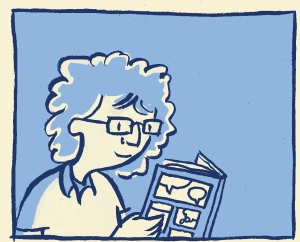“The birth of the reader must be ransomed by the death of the Author.”
(Barthes,1998, p. 386)
The issue of representation in children’s literature has been on high octane overdrive for the last 18 months or so. For me, the breaking point was the advent of the We Need Diverse Books social media campaign. The twitter conversation exploded into a full on outcry from readers and authors. There were and continue to be many bloggers who are focused on issues of representation, and the work is becoming part of a larger conversations about race and privilege that have been a long time coming. These conversations are not easy, they are not comfortable, and there are no easy answers.
Recently, another picturebook, A Birthday Cake for George Washington, featuring the all too familiar happy-slave trope. Click here to link to an article by Hillel Italie that provides an overview of the issues.
I had heard about the Cake from other scholars in children’s literature, but it wasn’t until I attended the American Library Associations Mid-winter conference here in Boston that I got a chance to see it. It would be easy to say I was shocked, or surprised. But, what is hard for me to admit is that I wasn’t caught off guard at all. I am rarely surprised by the tropes used in children’s literature and other media that reduce people and cultures to collections of stereotypes and caricatures. I am not surprised when books avoid the terrible truths in our collective history.
There is a strong contingent of smart, caring people in the children’s literature community who I disagree about representations like those in A Fine Desert and A Birthday Cake for George Washington. In the past I have found it difficult to participate in these conversations about privilege and Whiteness, and representation. I get mad and start to rant. I scare the dogs. I threaten my computer. But, I am working on sitting and thinking, instead of standing and yelling. And, in this space I am going to talk about an often used defense about books that have objectionable representations of people, cultures, and history.
The Good People Argument
- The author is a good person
- The author did not intend malice
- There is a note in the back of the book that explains the authors intention
- Therefore, no one should take offense at the depiction of an under-represented person or culture in the actual body of the text
I have never understood this argument. By in large, I do not know the authors of the books I read. I don’t know Dorothy Parker, Kurt Vonnegut, William Saroyan or Douglas Adams (some of my favorite dead authors). And although I have met Andrew Smith, Nathan Hale, and Laurie Halse Anderson (some of my favorite not-dead authors) I can’t say I know them. And, it shouldn’t matter. Their intent or general personhood cannot matter to me as the reader. Barthes, a French literary critic, wrote about the end of the author’s control of the story.
The author’s intentions when creating a book are changed by time and experience. Once an author has written an imagined scene, or person, or event with all the emotions attached, the idea is changed by the act of writing. The author is changed as well. Books are created by change. They are imagined, dreamed, doodled, written, rewritten, edited, proofed, thought about, talked through, destroyed and reborn in a million ways. By the time I begin to read the author has faded, and in their place stands the book. The intention has dissipated into time and space and events of the day. The intent has no baring on the object in front of me. It it my responsibility to make sense of the book, using all I have at my disposal; my experiences, my understanding, my interpretation.
I care about the book in front of me. The story, the characters, the language and what it makes me see and feel and how it affects me. I’m glad the author exists, so that they can write again, because I am a greedy reader. Unfortunately, that is the contract an author agrees to when they write and send a book out into the world. The book must represent itself to me, the reader.
References
Barthes, Roland. “The Death of the Author.” Art and Interpretation: An Anthology of Readings in Aesthetics and the Philosophy of Art. Ed. Eric Dayton. Peterborough, Ont.: Broadview, 1998. 383-386. Print.

These final two paragraphs are a gift to every avid reader who loves to think about what it means to read a book. Thank you for taking the time to sit and think and share. We owe you, big time.
Thank you for the shout out! Glad you enjoyed.
What a wonderful post! So many great points. Here’s what popped into my mind upon reading it.
A racist author/artist is certainly bad. But to me it’s not the worst part of this story. That distinction goes to the fact that this book is the product of a slick, wealthy publishing/education conglomerate. This means that before the book ended up in the hands of children, it was first approved and signed-off on by countless people. Agents, publishers, editors, illustrators, stock holders, CEOs, etc. This is proof of hegemony. When artifacts like this are continuously conceived of, approved, created, and sold on a large-scale level.
I also love the way you mention the constant flux between author/ideas/words. Makes me think about Peter Elbow’s ideas of writing, revision, and freewriting.
Thank you, Sherri, for introducing me to this blog!
Oh! You are the second person to mention Peter Elbow to me. I need to go back and do some re-reading. Thank you for reading and sharing.